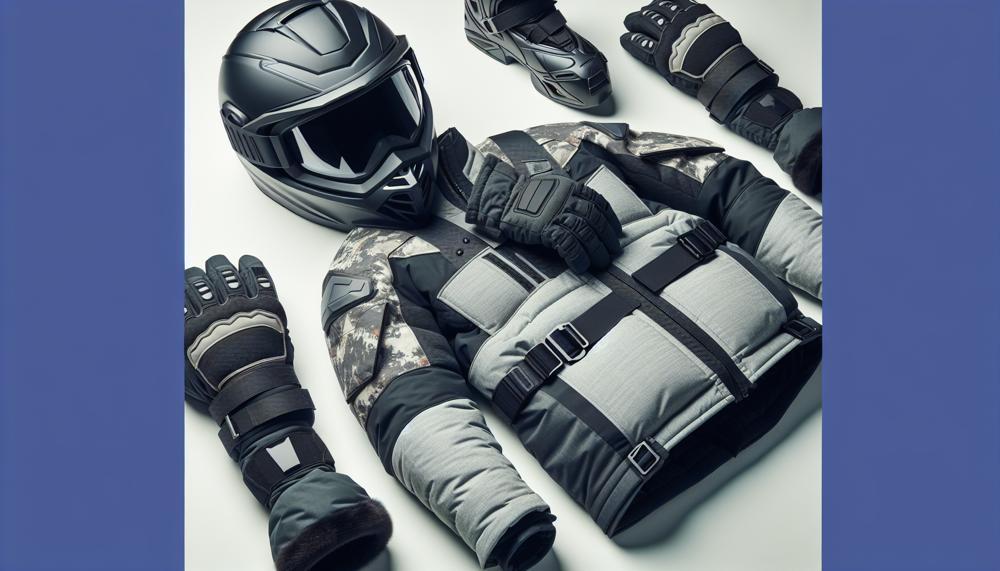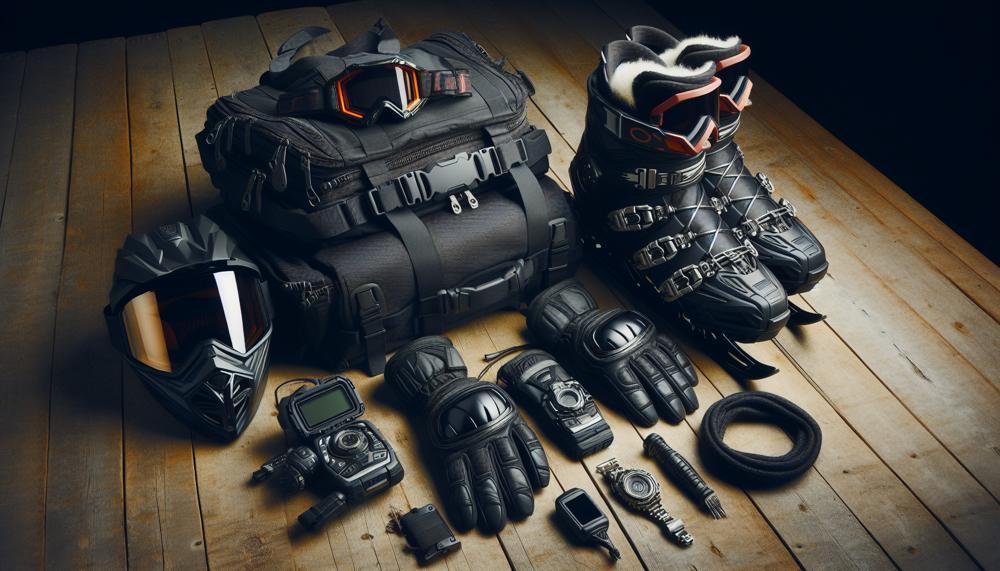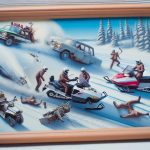Are you tired of feeling cold and uncomfortable while riding your snowmobile? Layering is key when it comes to staying warm and comfortable on the trails. We’ll share some tips on how to properly layer your clothing for maximum warmth and flexibility. But that’s not all – we’ll also cover waterproof and windproof outerwear options to keep you dry and protected from harsh weather conditions.
Safety is always a top priority when it comes to any sport, especially snowmobiling. That’s why we’ll also discuss protective gear such as helmets, gloves, and goggles that are essential for a safe ride. And let’s not forget about boots – choosing the right pair with proper insulation and traction can make all the difference in your riding experience.

So, what to wear when snowmobiling?
When snowmobiling, you should wear clothing that retains heat and doesn’t absorb moisture. Here are some things you can wear while snowmobiling:
- Helmets: A riding helmet is essential gear for snowmobiling.
- Boots: Boots should be waterproof, warm, and supportive. Snowmobiles have sharp edges where your feet go, so boots will take a beating.
- Snowmobile pants: Snowmobile pants should keep your lower half of your body warm, dry, and comfortable all day.
- Gloves: Gloves should repel water and wind and keep your hands warm. You should also choose gloves that allow you to operate your snowmobile freely and comfortably.
- Jacket: A parka or heavy winter coat can provide full-body warmth.
- Facemask: A balaclava can keep your head and face warm while riding.
- Outer shells: A shell and pants can protect you against the elements and should be waterproof.
- Goggles: Goggles can give you better visibility in the snow and protect you from things flying into your eyes.
Whether you’re a seasoned pro or new to snowmobiling, having the right attire is crucial for an enjoyable experience. So let’s get ready to hit the trails in style.
Understanding the Importance of Proper Attire for Snowmobiling
Contents
When it comes to snowmobiling, proper attire is vital for both comfort and safety. Spending extended periods in cold, wet, and windy conditions makes it crucial to have the right gear to stay warm and dry. Exposure to extreme temperatures can lead to frostbite, hypothermia, and other cold-related injuries, making appropriate clothing a must. With the high-risk terrain and speed involved in snowmobiling, protective gear is also essential for preventing accidents and injuries.
Wearing the right attire allows for better mobility and flexibility while riding, reducing the chances of falls or accidents. The appropriate layers can help regulate body temperature, preventing overheating or dehydration, which is crucial for maintaining energy levels during long rides. Proper attire also enhances visibility and protects against debris or flying snow particles, reducing distractions while on the go.
Thermal socks, waterproof and insulated layers, a helmet with face protection, goggles or sunglasses, and hand warmers are all essential pieces of clothing for snowmobiling. Layering is key in providing warmth and comfort while riding. Cotton should be avoided as it does not offer enough warmth or protection. Instead, synthetic fabrics like polyester or merino wool are recommended for base layers.
Helmets are also a must when snowmobiling as they can reduce fatal head injuries by 40%. A full-face helmet is preferred for better eye protection, and a balaclava or full face mask can provide additional coverage from harsh winds. Protective goggles are necessary to safeguard eyes from frostbite and debris while riding.
In addition to traditional layers, heated outerwear or electrically heated accessories can provide extra comfort during long rides. It is also recommended to consume complex carbohydrates before riding to maintain energy levels and pack high-energy snacks for quick pick-me-ups.
Staying hydrated by drinking plenty of water is also crucial for regulating body temperature.
Key Factors to Consider when Choosing Snowmobiling Clothing
When it comes to snowmobiling, having the right clothing is crucial for safety and comfort while on the trails. There are several key factors to keep in mind when choosing snowmobiling attire:
- Insulation: The first and most important factor to consider is insulation. It’s essential to choose clothing that will keep you warm in cold temperatures. Layering is the most effective way to achieve proper insulation, and synthetic fabrics like polyester or fleece are ideal for this purpose.
- Waterproofing: Snowmobiling often involves cold and damp conditions, so waterproofing is a must. Look for clothing with a waterproof rating of at least 5,000 mm to ensure protection against moisture.
- Wind Protection: Wind can significantly affect your body temperature while snowmobiling, so it’s crucial to choose clothing with good wind protection. Materials like Gore-Tex or nylon provide excellent wind resistance.
- Mobility and Flexibility: Snowmobiling requires a lot of movement, so it’s crucial to choose clothing that allows for mobility and flexibility. Avoid tight-fitting clothing that restricts movement.
- Visibility: Since snowmobiling often takes place in low-light conditions, high visibility clothing is a must. Brightly colored or reflective materials can help improve visibility and prevent accidents.
- Protection: Safety should always be a top priority when choosing snowmobiling attire. Investing in a high-quality helmet with goggles and gloves provides added protection against potential hazards on the trails.
Aside from these critical factors, there are also some essential gear and accessories to consider when choosing snowmobiling attire. These include insulated gloves, thermal socks, and a helmet with face protection. Goggles should also be worn to protect against frostbite and debris from the trails.
For extra comfort during longer rides, consider investing in heated outerwear or electrically heated accessories. Hand warmers are also a must-have for continuous warmth.
Lastly, avoid wearing cotton clothing as it does not provide adequate insulation and can become damp and uncomfortable when exposed to moisture. Proper footwear, such as boots with good traction, is also essential for safety while snowmobiling.
Essential Snowmobiling Gear You Shouldn’t Forget
Riders should always be equipped with the key essentials for snowmobiling adventures. These are essential snowmobiling gear items that can make a difference between an enjoyable and safe ride or a dangerous and uncomfortable one.
| Snowmobile Gear | Description |
| Base Layers | The base layers are made from insulated and moisture-wicking materials such as polypropylene, rayon, or Merino wool. These fabrics help keep you warm while managing sweat to ensure comfort during your ride. |
| Mid Layers | Mid layers come with added features such as hoods and pockets and can be made from various fabrics like polyester-fleece blends or synthetic materials. These layers provide additional warmth and convenience for riders. |
| Outerwear | This gear is crucial for protection against harsh elements and comes in various options such as Gore-Tex or nylon. It is essential to choose outerwear that can withstand extreme weather conditions. |
| Snowmobile Suits | The snowmobile suit is a well-insulated, waterproof gear designed specifically for snowmobiling. These suits feature reinforced padding and reflective elements for added safety on the road. |
| Snow Pants, Body Armor, Chest Protectors | While optional, these gears are highly recommended for added protection during rides. They provide extra padding and insulation to keep riders safe and comfortable. |
| Socks | Socks made from moisture-wicking materials like Merino wool or synthetic blends are essential for keeping feet warm and dry during rides. |
| Gloves | Insulated, waterproof gloves with adjustable wrist closures are necessary for warmth and control while riding. These gloves should be able to withstand extreme weather conditions and provide a secure grip on the handlebars. |
| Balaclavas or Neck Gaiters | Multipurpose protection against wind and moisture-wicking properties make these gears a must-have for riders. They provide added warmth and comfort, especially in cold weather. |
| Goggles | Vital eye protection against snow, wind, and debris is essential for safety during rides. Goggles with anti-fog and UV features can help improve visibility and prevent accidents on the road. |
| Helmet | The helmet is an essential gear for head protection and insulation against cold temperatures. Riders can choose between full-face or open-face options depending on their preferences. |
Layering Techniques for Optimal Comfort and Safety on the Snowmobile
Layering is a crucial aspect to keep in mind when planning for a snowmobiling excursion. Not only does it enhance comfort, but it also ensures safety while riding through the snowy landscapes.
Let’s explore some key techniques for optimal layering, taking into consideration the purpose and recommended materials for each layer.
| Layer | Purpose | Recommended materials |
| Base layer | Efficiently wicks away moisture, keeping you dry and comfortable | Synthetic materials like polyester or merino wool are ideal for this layer |
| Mid-layer | Provides insulation by trapping heat close to your body | Fleece, down, or wool are excellent options for this layer |
| Outer layer | Offers protection from the elements such as wind, snow, and water | Snowmobile-specific jackets and pants with high waterproof ratings and breathable materials are recommended for this layer |
| Accessories (head, hands, feet) | Extra protection for extremities that are often exposed to harsh conditions while riding | A warm hat or balaclava, waterproof gloves or mittens, and insulated boots are essential accessories to consider |
| Additional layers (optional) | For added warmth in extreme temperatures or long rides where extra insulation is needed | A down vest or an extra pair of socks can be useful additions to your layers, but be cautious not to add too many layers as it can restrict movement and become uncomfortable. |
It’s crucial to always dress in layers and adjust accordingly based on weather conditions to ensure a safe and enjoyable snowmobiling experience.
Keep in mind that layering not only enhances comfort but also provides vital protection against the elements, making it an essential aspect of preparing for a snowmobiling adventure.
Also Read: How Long Do Snowmobile Belts Last?
Conclusion
In conclusion, proper attire is crucial for a safe and enjoyable snowmobiling experience.
The key to staying warm and protected on the trails is layering techniques, waterproof and windproof outerwear, and protective gear such as helmets, gloves, and goggles. But it’s not just about staying warm – visibility is also important for safety.
So don’t forget to choose appropriate footwear for added traction on the snowy terrain. Remember to dress in layers and adjust accordingly based on weather conditions.
And when it comes to extreme temperatures or longer rides, make sure to have additional layers ready for added warmth.






